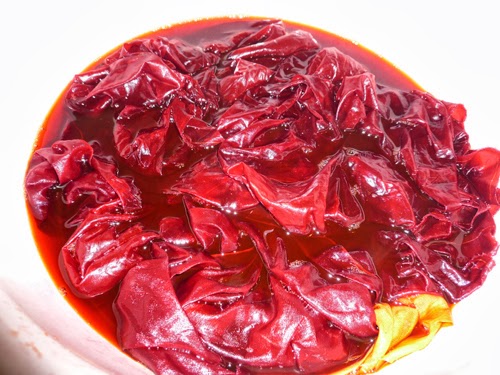The processes of dyeing with gardenia and sappan wood are quite simple but they make so gorgeous color. If you can get gardenia and sappan wood then why don't you try to do dyeing silk through the way below?
Dyeing using Gardenia
1. Keep gardenia soaked in water for half the day and then boil it. Simmer it another 30 mins after it has boiled.(Boiling term can be modulated by the dyeing materials' condition. It means that if the coloring looks enough then boil it for just 10 mins more).
2. Prepare Alum. I don't like using chemical fixative, so usually use a bit mild burnt alum which is sold at Oriental medical clinic.(They sell burnt alum which is edible.) Dissolve the burnt alum(5% of the fabric weight) completely in 50degrees water and put the silk in it. Keep the silk like that with kneading sometimes for 20 mins.(the liquid not thrown away after that)
3. Prepare dyeing solution. Shift well the boiled gardenia. The solution temperature needs to be 60 degrees.(That's suitable for silk) Put finished step 2's silk into the solution and dye it about 30 mins. If you knead the fabric well at this time the coloring would be better.
4. Put the dyed fabric into step 2(Alum water) for fixing color and knead it for 15 mins.
5. Rinse the silk with water and dry it in shade. The picture below is the result of dyeing Silk Dupioni Organza with gardenia.
Dyeing using Sappan wood
Sappan wood is a plant growing in the tropical regions and the red-yellow wood part is used for reddish dyestuff. The terms of keeping steeped sappan wood in water depends on the state of the wood before dyeing. Generally soak it about 3~4 hours then extract dyeing solution but it should be in water the day before dyeing if the wood is in so dried state. Using the alkali water(ph8~9) for dyeing deep red color. I didn't use the alkali for changing the color, just used for extract deep red coloring. The process of below is about intense red dyeing using sappan wood.
1. Soak the sappan wood in water for 3~4 hours before dyeing.
2. Prepare water which is alkali(ph8~9) and put the soaked sappan wood in water and boil it.
I used 'Natural Lime Powder' instead 'Casutic Soda' for making alkali water. (At the moment in Korea, people are dyeing naturally as traditional ways with Natural Lime Powder and avoiding using chemical fixatives more and more..) The sappan wood is helpful to be extracted the solution when it's boiled in alkali water.
3. Shift well dyeing solution of sappan wood and do the step 2 once again. That is, use the extracte sappan wood again and mix the solutions from fitst and second step. It will be dyeing solution.
4. Prepare water for color-fixing with alum. Dissolve alum(5% of the fabric weight) completely in 50 degrees water and put the silk in it. Keep the silk like that with kneading sometimes for 20 mins.
(keep the alum water for another step) This part makes the fabric coloring effectively. The sappan wood come out well for dyeing but the fastness of original color is not as good as gardenia so shouldn't skip this step.
5. Neutralize the prepared dyeing solution of step 3 using vinegar or citric acid.(ph7)
I needed perfectly red color so I neutralized the alkali dyeing solution before dyeing.
For your information, if you dye with alkali state of water then you can get violet series but the fastness of color is worse than reddish color.
6. Put the fabric into the solution and dye it.
The water was about 50 degrees and dyeing time took an hour. The high temperature needs short time to dye and the low one needs more. I did it with low temerature for reducing the risk from dyeing that silk might have. If the fabric has stains when you dye then the low temperature and long time can be one of the key.
7. The dyed fabric needs to be soaked in water(step.4) for color-fixing. About 15 mins with kneading needed.
8. Rinse and dry it in shade.
Tip!
For coloring an orange, do dye the fabric by gardenia first and then dye it by sappan wood again. In that case, that's okay with the gardenia dyeing through the way of above. But the sappan wood dyeing needs to be check the color during the dyeing and should be dyed 5 mins more after getting color you want, then the proper color comes out.













No comments:
Post a Comment